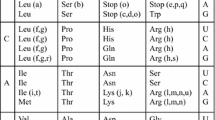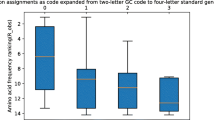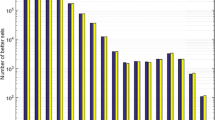Abstract
Since the genetic code first was determined, many have claimed that it is organized adaptively, so as to assign similar codons to similar amino acids. This claim has proved difficult to establish due to the absence of relevant comparative data on alternative primordial codes and of objective measures of amino acid exchangeability. Here we use a recently developed measure of exchangeability to evaluate a null hypothesis and two alternative hypotheses about the adaptiveness of the genetic code. The null hypothesis that there is no tendency for exchangeable amino acids to be assigned to similar codons can be excluded here as expected from earlier work. The first alternative hypothesis is that any such correlation between codon distance and amino acid distance is due to incremental mechanisms of code evolution, and not to adaptation to reduce deleterious effects of future mutations. More specifically, new codon assignments that occur by ambiguity reduction or by codon capture will tend to give rise to correlations, whether due to the condition of amino acid ambiguity, or to the condition of similarity between a new tRNA synthetase (or tRNA) and its parent. The second alternative hypothesis, the adaptive hypothesis, then may be defined as an excess relative to what may be expected given the incremental nature of evolution, reflecting true adaptation for robustness rather than an incidental effect. The results reported here indicate that most of the nonrandomness in the amino acids to codon assignments can be explained by incremental code evolution, with a small residue of orderliness that may reflect code adaptation.



Similar content being viewed by others
References
Cavalcanti AR, Leite ES, Neto BB, Ferreira R (2004) On the classes of aminoacyl-tRNA synthetases, amino acids and the genetic code. Orig Life Evol Biosph 34:407–420
Crick FHC (1968) The origin of the genetic code. J Mol Biol 38:367–379
Davis BK (1999) Evolution of the genetic code. Prog Biophys Mol Biol 72:157–243
Di Giulio M (2001) The origin of the genetic code cannot be studied using measurements based on the PAM matrix because this matrix reflects the code itself, making any such analyses tautologous. J Theor Biol 208:141–144
Di Giulio M (2005) The origin of the genetic code: theories and their relationships, a review. Biosystems 80:175–184
Freeland SJ, Hurst LD (1998) The genetic code is one in a million. J Mol Evol 47:238–248
Freeland SJ, Wu T, Keulmann N (2003) The case for an error minimizing standard genetic code. Orig Life Evol Biosph 33:457–477
Grantham R (1974) Amino acid difference formula to help explain protein evolution. Science 185:862–864
Kawashima S, Kanehisa M (2000) AAindex: amino acid index database. Nucleic Acids Res 28:374
King JL (1971) The influence of the genetic code on protein evolution. In: Schoffeniels E (ed) Biochemical evolution and the origin of life. North-Holland, Viers, pp 3–13
Knight RD, Freeland SJ, Landweber LF (2001) Rewiring the keyboard: evolvability of the genetic code. Nat Rev Genet 2:49–58
Nagel GM, Doolittle RF (1995) Phylogenetic analysis of the aminoacyl-tRNA synthetases. J Mol Evol 40:487–498
O’Donoghue P, Luthey-Schulten Z (2003) On the evolution of structure in aminoacyl-tRNA synthetases. Microbiol Mol Biol Rev 67:550–573
Osawa S (1995) Evolution of the genetic code. Oxford University Press, New York
Salazar JC, Ahel I, Orellana O, Tumbula-Hansen D, Krieger R, Daniels L, Soll D (2003) Coevolution of an aminoacyl-tRNA synthetase with its tRNA substrates. Proc Natl Acad Sci USA 100:13863–13868
SAS Institute (2002) JMP statistics and graphics guide. SAS Institute, Cary, NC
Schultz DW, Yarus M (1996) On malleability in the genetic code. J Mol Evol 42:597–601
Sneath PHA (1966) Relations between chemical structures and biological activity in peptides. J Theoret Biol 12:157
Trifonov EN (2000) Consensus temporal order of amino acids and evolution of the triplet code. Gene 261:139–151
Trifonov EN (2004) The triplet code from first principles. J Biomol Struct Dyn 22:1–11
Wagner A (2005) Robustness and evolvability in living systems. Princeton University Press, Princeton, NJ
Whelan S, Goldman N (2004) Estimating the frequency of events that cause multiple-nucleotide changes. Genetics 167:2027–2043
Woese CR, Dugre DH, Dugre SA, Kondo M, Saxinger WC (1966) On the fundamental nature and evolution of the genetic code. Cold Spring Harb Symp Quant Biol 31:723–736
Xia X, Li WH (1998) What amino acid properties affect protein evolution? J Mol Evol 47:557–564
Yampolsky LY, Stoltzfus A (2005) The exchangeability of amino acids in proteins. Genetics 170:1459–1472
Zuckerkandl E, Pauling L (1965) Evolutionary divergence and convergence in proteins. In: Bryson V, Vogel HJ (eds) Evolving genes and proteins. Academic Press, New York
Acknowledgments
The authors thank Steve Freeland and three anonymous reviewers for advice and comments. The identification of specific commercial software products in this paper is for the purpose of specifying a protocol, and does not imply a recommendation or endorsement by the National Institute of Standards and Technology.
Author information
Authors and Affiliations
Corresponding author
Rights and permissions
About this article
Cite this article
Stoltzfus, A., Yampolsky, L.Y. Amino Acid Exchangeability and the Adaptive Code Hypothesis. J Mol Evol 65, 456–462 (2007). https://doi.org/10.1007/s00239-007-9026-8
Received:
Revised:
Accepted:
Published:
Issue Date:
DOI: https://doi.org/10.1007/s00239-007-9026-8




